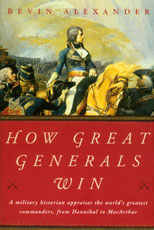 Click here to purchase from Barnes & Noble.
Click here to purchase from Amazon.com.
Click here to purchase from Barnes & Noble.
Click here to purchase from Amazon.com.
Maneuvering on the Rear of the Enemy
Excerpt from How Great Generals Win, by Bevin Alexander, pages 301-02
By demonstrating with part of his army at Valenza on the Po River in northern Italy in 1796, Napoleon convinced the Austrian commander this was the sole French target, drawing Austrian defenders to that point. Napoleon then marched the majority of his forces downstream to Piacenza, thereby turning all possible enemy lines of defense, and forcing the Austrians to abandon all of northern Italy except the fortress of Mantua. (See page 107.)
Stonewall Jackson in 1862 convinced the Federal commander Nathaniel Banks he was driving directly on Strasburg in the Shenandoah Valley, where Banks had concentrated most of his army. Instead, Jackson crossed Massanutten Mountain, seized Front Royal in the enemy rear, cut the direct rail link with Washington, and forced the Union forces into disorderly retreat. (See page 133.)
In September 1918, Britain’s General Allenby feinted against the eastern front of the Turkish and German army in Palestine but struck unexpectedly against the western flank near the Mediterranean, breaking a large gap in the enemy line. Cavalry and armored cars now rushed through, quickly traversed the Plain of Sharon, seized the passes in the Mount Carmel massif, and blocked all Turkish rail lines and routes of retreat northward.. The Turkish-German army disintegrated as it tried to flee eastward into the Jordan Valley. British and Arab forces advanced on Damascus, Syria, and beyond, inducing Turkey’s surrender on October 31. (See page 184.)
In early 1941 a British force led by nineteen tanks got around the Italian army retreating along the coastal highway in Libya and formed a strategic barrage at Beda Fomm. There the British armor destroyed most Italian tanks attempting to withdraw. Without tank support and cut off from their retreat route, the remainder of the Italian army surrendered. (See page 242.)
While almost the entire North Korean army was pressing United Nations forces into a narrow perimeter around Pusan in southern Korea in 1950, General Douglas MacArthur invaded Inchon far to the north by sea, severed the main highways and only double-tracked railway in Korea, and, by cutting off supplies and reinforcements, caused the North Korean army to disintegrate. (See page 284.)
<< More 'Rules of War' Excerpts << Back to top